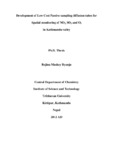Please use this identifier to cite or link to this item:
http://archive.nnl.gov.np:8080/handle/123456789/292| Title: | Development of low cost passive sampling diffusion tubes for spatial monitoring of NO2, SO2 and O3 in Kathmandu valley |
| Authors: | Maskey Byanju, Rejina |
| Keywords: | Diffusive Nitrogen dioxide Sulphur dioxide Ozone |
| Issue Date: | 25-Feb-2018 |
| Abstract: | The work embodied in this research was to find out the solution for the difficulties often encountered by the resource limited countries in using high cost automatic instruments for air pollution monitoring and assessment. Monitoring and assessment is an important aspect in the protection of the public from the air -pollution –induced- health- hazard by improving exposure assessment and formulating mitigations. The overall goal of this study was to develop low cost passive samplers logistically feasible and technically suitable to use for ambient NO2, SO2 and O3 monitoring in Kathmandu. Locally available polyethylene tubes were developed as diffusion tubes for ambient passive sampling. These tools were then applied to assess the spatial variability in NO2, SO2 and O3 across the Kathmandu valley. The passive measurements include development of these tubes into diffusive tubes using triethanolamine (TEA) for NO2, SO2 and nitrite- coated filter (GF/A filter paper) for O3 as absorbent bases. After extraction with water, modified Griese-Saltzmann method and West- Gaeke method were used for analysis of nitrite and sulphate adduct formed due to reaction of NO2 and SO2 respectively. Azide modified sodium salicylate method was used for analysis of nitrate formed by the oxidation of nitrite by ozone from the air using uv visible spectrophotometer. The results were compared with ferm- badge type passive samplers from IVL-Sweden and other active methods. The detection limits of the passive sampling methods were found to be suitable for use in tested environment. The instrumental detection limits obtained from calibration curve were 0.09 μg/ml and 0.05μg/ml for NO2 – and SO4 2- , respectively. The detection limits of NO2 were in the range of 1.75 to 2.73 μg/m3; and that for SO2 were 1.12 to 5.85μg/m3 for different tested exposure periods. Precision of the method as expressed as coefficient of variation was good enough for the monitoring of NO2 SO2 and O3 in ambient air of Kathmandu. The method showed strong correlation with high volume sampler and no significant difference with ferm badge –IVL samplers at p=0.05. Precision of the passive sampling method for measurement expressed as coefficient of variation (CV) was 13.3% with an overall range of 2.3-20.8% for NO2 and it was 14.5% with an overall range of 3.4-20.2%. The results of all the exposure analysis provided a reliable ambient O3 sampling with good precision. Precision of O3 measurements were found to be in the range of 0.1 to 14%. The prepared diffusion tubes were suitable for 24 hour sampling in the tested environments. The tested method overestimates of 22.77% and 7.9% in compare to that of automated ozone analyzer and Ferm-IVL sampler respectively. The result was acceptable according to US National Institute of Safety and Health (Seethapathy et al., 2007) The limit of detection for developed passive sampling method was 0.011 μg/ m3, which was suitable to measure O3 in the study area . The passive monitoring and the assessment of the quality of air prevailing in the urban Kathmandu revealed that all the three pollutants monitored NO2, SO2 and O3 concentrations in winter dry season were higher than in rainy season. NO2 and SO2 were below National Ambient Air Quality Standard (NAAQS) for both the monitoring period however, NO2 at several points exceeded the NAAQS. Higher concentrations of NO2 were observed at the high traffic density areas. Transportation was the major source of NO2 in the city. SO2 pollution in the city other hand was related with the industrial emission especially due to the brick kilns and hotels. The O3 concentrations varied between 25 and 100 μg /m3 with an average of 47 μg /m3. The maximum was observed from rural site Matsygaun while minimum observed from Baudha. The pre-monsoon months specially March –May was the most vulnerable period for high concentration ozone exposure in Kathmandu valley. |
| Description: | A Thesis submitted to the Central Department of Chemistry, Institute of Science and Technology, Tribhuvan University, for the degree of Doctor of Philosophy (Ph. D) in Chemistry, 2012. |
| URI: | http://103.69.125.248:8080/xmlui/handle/123456789/292 |
| Appears in Collections: | 500 Natural sciences and mathematics |
Files in This Item:
| File | Description | Size | Format | |
|---|---|---|---|---|
| rejina-PhD thesis.pdf | 2.43 MB | Adobe PDF |  View/Open |
Items in DSpace are protected by copyright, with all rights reserved, unless otherwise indicated.